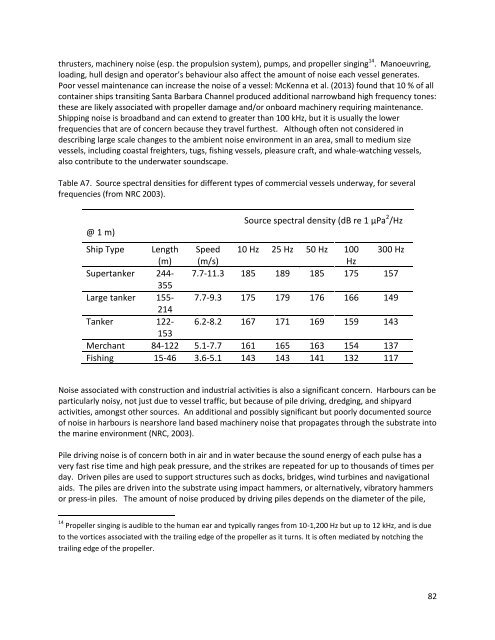mcbem-2014-01-submission-wwf-en
mcbem-2014-01-submission-wwf-en
mcbem-2014-01-submission-wwf-en
You also want an ePaper? Increase the reach of your titles
YUMPU automatically turns print PDFs into web optimized ePapers that Google loves.
thrusters, machinery noise (esp. the propulsion system), pumps, and propeller singing 14 . Manoeuvring,<br />
loading, hull design and operator’s behaviour also affect the amount of noise each vessel g<strong>en</strong>erates.<br />
Poor vessel maint<strong>en</strong>ance can increase the noise of a vessel: McK<strong>en</strong>na et al. (2<strong>01</strong>3) found that 10 % of all<br />
container ships transiting Santa Barbara Channel produced additional narrowband high frequ<strong>en</strong>cy tones:<br />
these are likely associated with propeller damage and/or onboard machinery requiring maint<strong>en</strong>ance.<br />
Shipping noise is broadband and can ext<strong>en</strong>d to greater than 100 kHz, but it is usually the lower<br />
frequ<strong>en</strong>cies that are of concern because they travel furthest. Although oft<strong>en</strong> not considered in<br />
describing large scale changes to the ambi<strong>en</strong>t noise <strong>en</strong>vironm<strong>en</strong>t in an area, small to medium size<br />
vessels, including coastal freighters, tugs, fishing vessels, pleasure craft, and whale-watching vessels,<br />
also contribute to the underwater soundscape.<br />
Table A7. Source spectral d<strong>en</strong>sities for differ<strong>en</strong>t types of commercial vessels underway, for several<br />
frequ<strong>en</strong>cies (from NRC 2003).<br />
@ 1 m)<br />
Source spectral d<strong>en</strong>sity (dB re 1 µPa 2 /Hz<br />
Ship Type L<strong>en</strong>gth Speed 10 Hz 25 Hz 50 Hz 100 300 Hz<br />
(m) (m/s)<br />
Hz<br />
Supertanker 244- 7.7-11.3 185 189 185 175 157<br />
355<br />
Large tanker 155- 7.7-9.3 175 179 176 166 149<br />
214<br />
Tanker 122- 6.2-8.2 167 171 169 159 143<br />
153<br />
Merchant 84-122 5.1-7.7 161 165 163 154 137<br />
Fishing 15-46 3.6-5.1 143 143 141 132 117<br />
Noise associated with construction and industrial activities is also a significant concern. Harbours can be<br />
particularly noisy, not just due to vessel traffic, but because of pile driving, dredging, and shipyard<br />
activities, amongst other sources. An additional and possibly significant but poorly docum<strong>en</strong>ted source<br />
of noise in harbours is nearshore land based machinery noise that propagates through the substrate into<br />
the marine <strong>en</strong>vironm<strong>en</strong>t (NRC, 2003).<br />
Pile driving noise is of concern both in air and in water because the sound <strong>en</strong>ergy of each pulse has a<br />
very fast rise time and high peak pressure, and the strikes are repeated for up to thousands of times per<br />
day. Driv<strong>en</strong> piles are used to support structures such as docks, bridges, wind turbines and navigational<br />
aids. The piles are driv<strong>en</strong> into the substrate using impact hammers, or alternatively, vibratory hammers<br />
or press-in piles. The amount of noise produced by driving piles dep<strong>en</strong>ds on the diameter of the pile,<br />
14 Propeller singing is audible to the human ear and typically ranges from 10-1,200 Hz but up to 12 kHz, and is due<br />
to the vortices associated with the trailing edge of the propeller as it turns. It is oft<strong>en</strong> mediated by notching the<br />
trailing edge of the propeller.<br />
82


